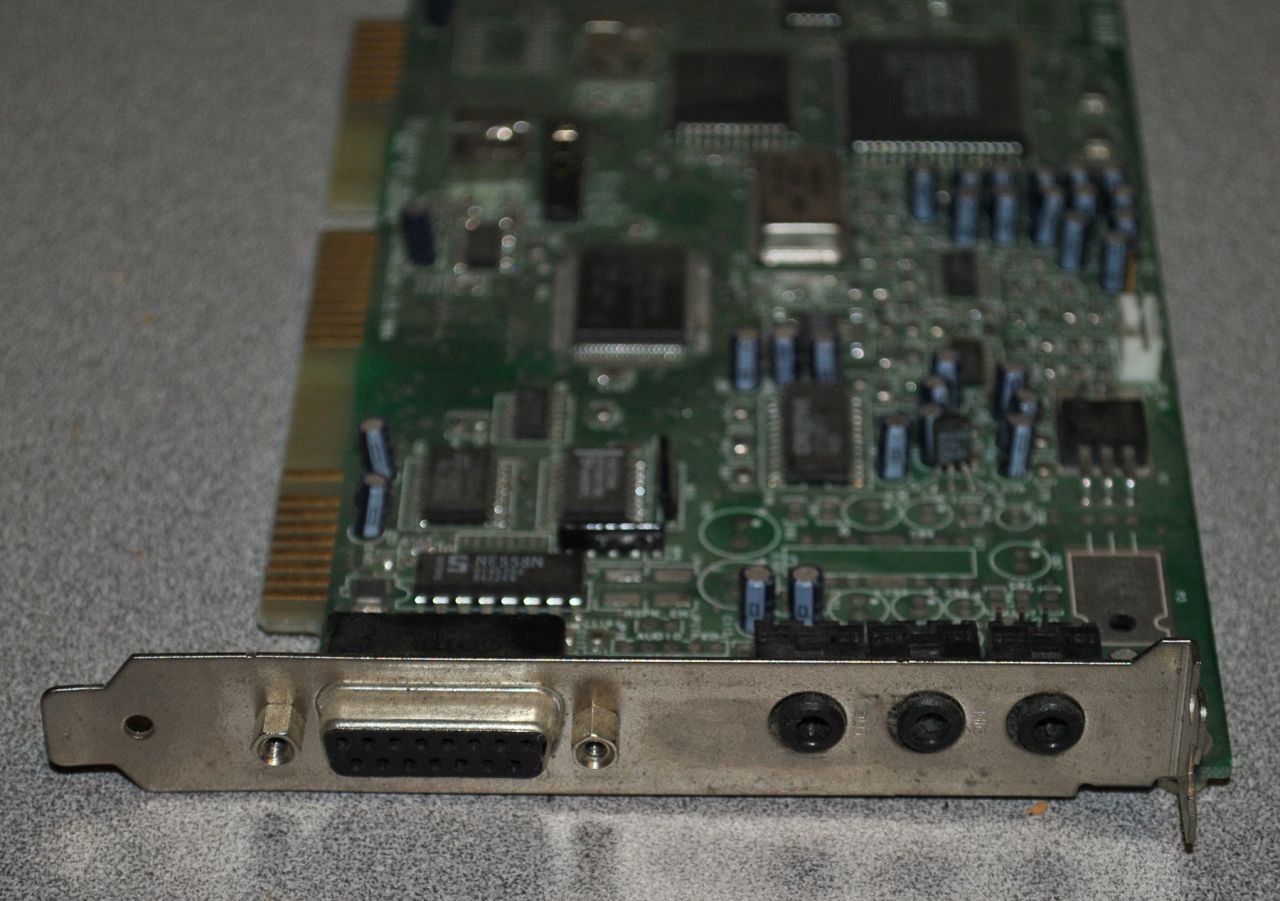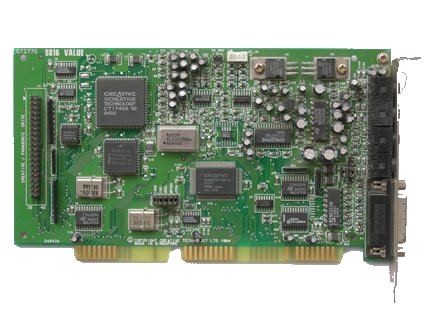Sound Blaster 16 (CT2770, CT2770A, CT2771, CT2772)
The CT2770, full name, Sound Blaster 16 Value Edition, was launched in 1994. Being a value edition card, it was pared down to the minimum - no wavetable header and only a Panasonic CD-ROM interface.
|
Released | 1994 |
| Bus | ISA 16-bit | |
| FM Synth | (Integrated Yamaha YMF262 in CT1747) | |
| Audio Codec | None | |
| Standards | Ad Lib, Sound Blaster, Sound Blaster Pro, Sound Blaster 16 | |
| Ports | Speaker-Out, Mic-In, Line-In, Line-Out Game/MIDI port |
|
| CD-ROM | Panasonic | |
| Wavetable | Wave Blaster header on CT2772 only | |
| Plug & Play | No (Auto-Init only) | |
| FCC ID(s) | IBACT-SB16VAL (CT2770, CT2770A, CT2771) IBACT-SB16NCDR (CT2772) |
|
| Price | Mar 1995: $139.95 | |
| See Also | Sound Blaster 16 (CT2230) |
Board revision 29409 was the original CT2770 and still had the other CD-ROM interface solder pads for Mitsumi and Sony drives, plus the CSP/ASP chip solder pads.
CT2770A then followed, removing these obsolete CD-ROM interface headers from the board as well as the CSP/ASP chip area.
Board revision 19423 got a Line Out socket, but this was removed in the final 39416 revision.
CT2771 is an odd card with no information anywhere on the web - let me know if you have any details of this card. Other Creative cards often used the '1' suffix to indicate it was a "value" version of the "0"-suffixed card, so this is perhaps a "value" on top of a "value" card ;-) Either that, or it's some OEM variant.
CT2772 was the same as the CT2770A, but got FCC ID: IBACT-SB16NCDR, which I can only assume means "No CD-ROM", as it didn't come with a CD-ROM interface, but this card did come with a wavetable header which is odd for a value edition card...
For this card, read the Noise Issues section further up this page.![]()
Fun fact... user Imperious on the Vogons forum says he successfully ran a CT2770 on an 8088 XT (8-bit ISA slots only). The 16-bit part of the card is used for the CD-ROM interface only! Imperious said it's great for running the PC speaker audio through the sound card and out of the speakers, though there's only a tiny amount of games that can use the card's abilities on a system that slow.
Audio from the CT2770 can be listened to on the following game pages:
Board Revisions
Known board revisions include 19423 (CT2770A), 29409 (CT2770), 39416 (CT2770A), and 49434 (CT2770A).
All revisions got the CT1745 mixer chip and the CT1741 DSP chip with either DSP v4.11, v4.12, or v4.13 (all with hanging note bug).
Competition
The Sound Blaster 16's primary enhancement over its predecessor (the Sound Blaster Pro) was its capability to playback 16-bit audio for a crisper, cleaner sound. Unfortunately, this wasn't heavily adopted by games developers who continued to use lower-quality samples. Because of this, buying a Sound Blaster 16 really didn't offer any benefit over a much cheaper 8-bit audio card unless you were into recording your own stuff. The marketing department at Creative Labs didn't care, however, and people bought Sound Blaster 16s like they were going out of fashion, thinking 16 bits were always twice as good as 8.
In 1994, there was plenty to choose from in the ISA sound card market, with a lot new cards to choose from. Gravis released the UltraSound Max which added a Crystal CS4231A-KL codec to their wavetable, finally giving the UltraSound backward-compatibility with Ad Lib, Sound Blaster and Sound Blaster Pro. Another card new this year that sported the same Crystal chip was the MediaTrix AudioTrix Pro which also came with a 2 MB onboard wavetable and the new Yamaha OPL4 chip
Lots of off-brand cards sporting other Crystal chipsets [CS4215, CS4216 and CS4248] were also out in large quantities.
ESS Technologies' introduced their second audio chipset, ES688, with five-channel mixer and 16-bit stereo recording and playback capability.
OPTi launched the successor to their 82C928 'MAD16' chipset with the 82C929A MAD16 Pro, which was essentially the same but added an MPU-401 UART and IDE CD-ROM interfaces.
New from the MediaVision camp were the Pro Sonic 16 SCSI, Pro 3D/Premium 3D, Deluxe and Deluxe 16 cards, all of which leveraged their new Jazz16 chipset. The Pro 3D and Premium 3D were the first to offer SRS Surround Sound on a sound card - something Creative Labs had not yet done.
Turtle Beach released their first 2nd-generation cards that comprised Tahiti, Rio wavetable daughterboard, and Monterey (a packaged up Tahiti and Rio combined) - all great, but didn't have the crucial backward compatibility with Ad Lib and Sound Blaster standards.
In the Media


A later advert showcasing the Value Editions of SB, SBPro and SB16, plus SB16 MultiCD and SCSI-2, and the AWE32 (October 1994)

The same advert over 2 pages (March 1995)
Setting it Up
There is no setup or installation details on file for the Sound Blaster 16.
Downloads
Operation Manual
Get in touch if you can provide this missing item! |
DOS and Windows 3.1 Utility Disks The original Sound Blaster 16 DOS and Windows 3.1 installation disks, marked Sound Blaster 16 |
. DOS and Windows 3.1 Utility Disks The original Sound Blaster 16/AWE DOS and Windows 3.1 installation disks, marked SDR-31STD-1-US (Revision 1). |
DOS and Windows 3.1 Utility Disks The original Sound Blaster 16 Value Edition disks, marked Sound Blaster 16 S16V-STD-01-ENG. |
DOS and Windows 3.1 Utility Disks The original Sound Blaster 16 Value Edition disks, marked Sound Blaster 16 S16V-STD-01-ENG. |
More Pictures



Sound Blaster 16 (CT2770, board revision 19423)

Sound
Blaster 16 (CT2770, board revision 29409)


Sound Blaster 16 (CT2770, board revision 39416)
.JPG)
.JPG)
Sound Blaster 16 (CT2770, board revision 49434), courtesy of DOS Days' contributor, Robert

.JPG)